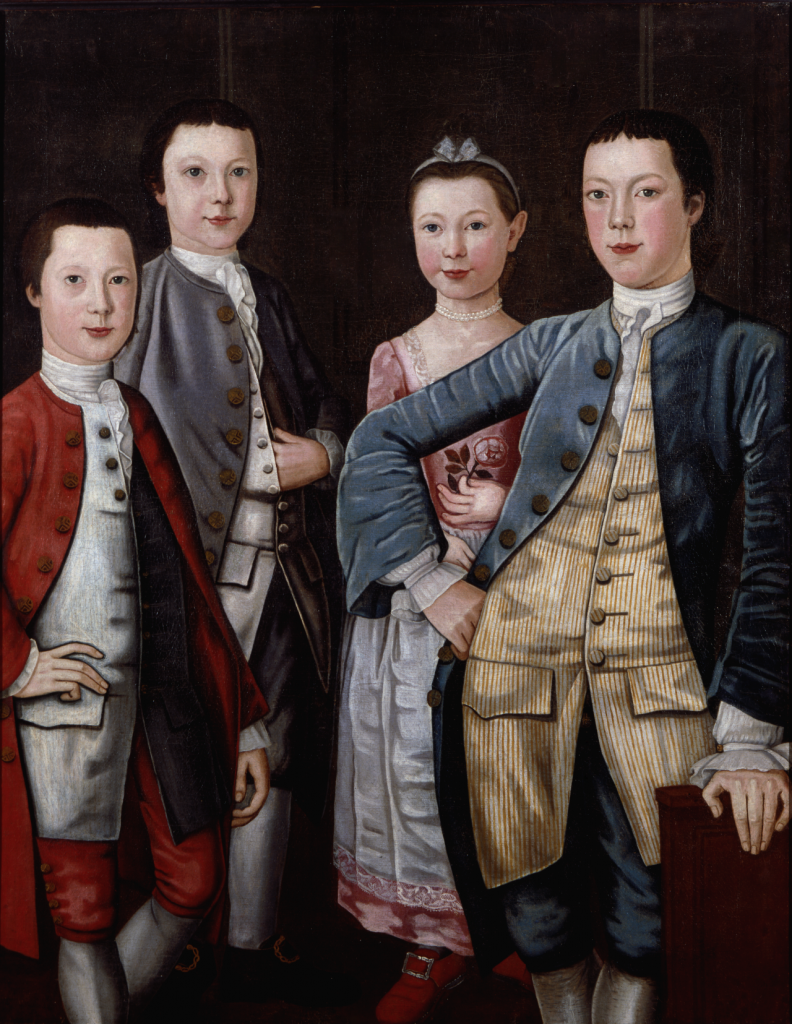Background
In the 1700s, class divisions became much more prominent in the English colonies. People with substantial property, or successful businesses, collected more and more of the colony’s wealth. This created a great divide in the social fabric of the colonies.
This portrait depicts the Rapalje children, descendants of some of the first settlers of New Amsterdam. They moved in the upper circles of British New York society.
While little is known about the artist John Durand, records indicate that he was a highly sought-after artist who painted portraits for many of New York’s most prominent families. The very existence of this portrait indicates that the Rapalje children lived lives of privilege and luxury compared with children of other social classes.
About the Image
Pictured, from left to right, are 11-year-old Garret, 13-year-old George, 6-year-old Anne, and 16-year-old Jacques. Their father, Garret Rapalje, was one of the many merchants of Dutch descent who found success trading for the British Empire. He also served as an assistant alderman in the 1760s. Their mother, born Helena De Nyse, was a descendant of another family with roots in the Dutch era. Rapalje commissioned this portrait by the noted American portraitist John Durand. It is considered one of his finest works and is his only known group portrait.
The portrait is full of small clues about the lives of the children. Their relaxed pose, which is unusual in colonial portraits, indicates their confidence in their status and upbringing, and their arrangement, which just barely fits within the canvas, suggests that they share a close family bond. Their brightly colored, textured clothing was likely made from fabric imported by their father. The young men are all dressed as colonial gentlemen in miniature, indicating their future place in society. Young Anne holds a rose, a sly reference to her fertility and fitness for marriage.
Vocabulary
- alderman: An elected member of a city council.
- merchant: A person involved in buying and selling large quantities of goods.
Pronunciation
- Rapalje: rah-pal-YE
Discussion Questions
- What does the clothing of these children reveal about the expectations of their roles in colonial society?
- What does the existence of this portrait reveal about the lives of the Rapalje family?
- What is the problem with relying on portraits to learn about the lives of people long ago?
Suggested Activities
- Use this image to show students the clothing and customs of the English colonies.
- Teach this image together with the recollections of Catalina Trico to trace the influence of the earliest settlers and rise of colonial families.
- Combine this image with the sampler and chatelaine for a lesson about the lives and expectations of wealthy colonial girls.
- Contrast this image of colonial girlhood with the indenture contract of Elizabeth Fortune, for a lesson on how race and class shaped the lives of girls in the English colonies.
- As a girl, Ann Rapalje’s future is severely curtailed by the legal and social customs of the English colonies compared with her brothers. Read The Last Will and Testament of Joseph Grover and Coverture to learn more.
- Combine this image with any of the following resources for a larger lesson about childhood in the American colonies: Life Story: Malitzen (La Malinche), Life Story: Kateri Tekakwitha, The Mourning Poetry of Anne Bradstreet, Life Story: Lisbeth Anthonijsen, Life on the Encomienda, The Middle Passage, Children at Work, The Business of Slavery, Education in New France, Life Story: Dennis and Hannah Holland, Life Story: Mother Esther Marie-Joseph Wheelwright de l’Enfant, Symbols of Accomplishment, The Casket Girls, and Eighteenth-Century Education.
Themes
DOMESTICITY AND FAMILY; AMERICAN IDENTITY AND CITIZENSHIP
New-York Historical Society Curriculum Library Connections
- For more resources relating to childhood in the English colonies, see New World—New Netherland—New York.







